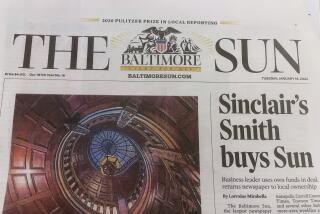Geffen may still have a chance
Will the next chapter in the Los Angeles Times ownership saga involve David Geffen?
The entertainment mogul’s $2-billion offer for the newspaper was rejected last year by its parent, Chicago-based Tribune Co.
Tribune, which was considering options including a sale of assets, said at the time that it intended to keep itself intact rather than sell off pieces.
But the company’s deal this week with billionaire entrepreneur Sam Zell to go private may well have changed the equation. Although Zell has also said that he intends to keep the company whole, the heavy debt load that Tribune would assume to complete the deal might force it to look for ways to raise large chunks of capital in a hurry.
The opportunities still exist to spin off The Times from Tribune in a tax-free transaction, according to Robert Willens, a tax expert and managing director at Lehman Bros. who has followed the Tribune deal closely. The ideal format, he said, would be a “sponsored spinoff,” an increasingly popular method for corporations to divest subsidiaries without incurring large tax bills.
Geffen said Monday that he would still like to acquire The Times. “I think there is an opportunity for Tribune Co. of Chicago to maximize shareholder value” by selling him the paper, he said after the Zell deal was announced.
Geffen has said that he hopes to meet with Zell at some point in the future. “I like Sam Zell,” he told The Times on Monday. “I wish him well with this new enterprise.”
A sponsored spinoff of The Times might allow Tribune to slash the amount of money it would need to borrow to take the company private under a Zell deal.
The spinoff might happen in several stages, Willens said. First, before a Zell deal was completed, Tribune would transfer The Times to a new company, which would then borrow, say, $1 billion, against the newspaper’s assets. Tribune could use those proceeds to offset its own debt or future borrowing. In the next step, a new partner -- in this example, Geffen -- would buy up to 49.9% of the Times company. The purchase would have to be for a stake of less than 50% to keep the transaction tax free. Tribune would distribute the remaining 50.1% of the stock in the new company to current shareholders on a tax-free basis.
Geffen’s purchase price would pay off the $1 billion in borrowing, with any excess going to Tribune. After an interval of as little as a year or two, Geffen could buy the rest of the Times shares, emerging as the newspaper’s 100% owner.
“It’s doable,” Willens said.
Geffen has told associates in the past that he would be amenable to taking control of the paper through a similar staged process.
Several obstacles would have to be addressed. Because Tribune has announced a sale to Zell, it might have to establish that some such process was considered independent of that transaction. Otherwise, federal tax authorities might challenge the tax-advantaged treatment of the spinoff. However, because of the variety of discussions Tribune has had over the last year about a restructuring, this might not be an impediment.
The deal would also have to be completed before Tribune converted to a Subchapter S corporation, a step in the Zell deal designed to make the new privately held corporation a tax-exempt entity. Under federal tax rules, any asset sale made by a corporation within 10 years of its conversion to an S corporation is heavily taxed.
Another important consideration is that The Times is Tribune’s single largest generator of cash flow, money that would be crucial to making principal and interest payments on the billions of dollars in new debt Zell will need to take the company private. In 2006, The Times produced $224 million in cash flow on operating revenue of $1.1 billion.
That means that Tribune management would have to balance the company’s cash-flow needs against the value of cutting its debt. The key calculation depends on whether the acquirer of a spun-off asset, in this case Geffen, would pay more in cash than the size of the debt that the lost cash flow would cover.
For example, The Times’ $224-million cash flow would cover the annual debt service on a $2.5-billion bond at 9% interest -- the rate that the heavily indebted Tribune might have to pay on its new debt. Management therefore would probably wish to be paid at least $2.5 billion for the asset.
Other factors might alter that calculation. One is that the structure proposed by Zell, designed to make Tribune Co. a tax-free entity, would increase the amount of debt that could be covered by a given cash flow and therefore reduce the price that might be demanded of a buyer.
Another factor is the continuing slide in newspaper revenues, which might lead Tribune to prefer an upfront payment for an asset such as The Times because of the risk that its cash flow would decline.
Such a calculation may have motivated Tribune’s announcement Monday that it would sell the Chicago Cubs after the current baseball season. As an operating subsidiary, the team breaks even, meaning that it produces virtually no cash flow. But it is expected to draw bids in the range of $500 million to $750 million. Tribune would use that money to pay off its debt.
james.rainey@latimes.com
More to Read
The biggest entertainment stories
Get our big stories about Hollywood, film, television, music, arts, culture and more right in your inbox as soon as they publish.
You may occasionally receive promotional content from the Los Angeles Times.











